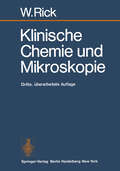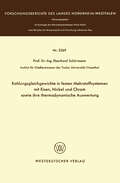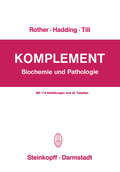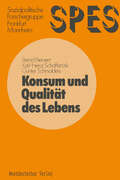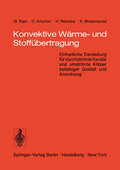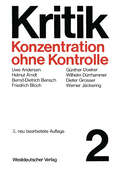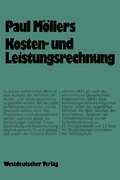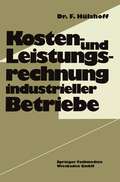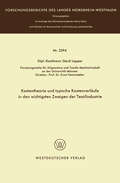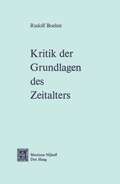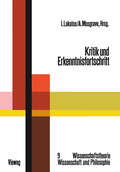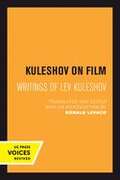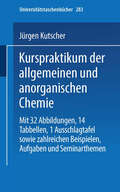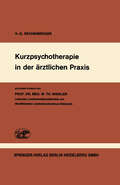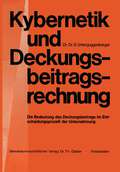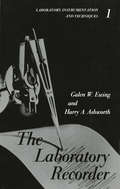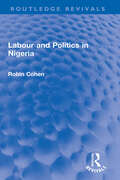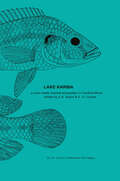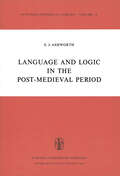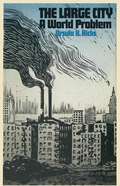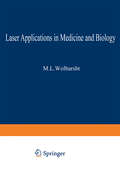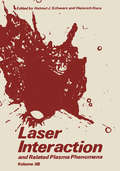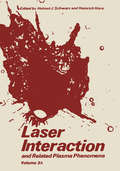- Table View
- List View
Kohlungsgleichgewichte in festen Mehrstoffsystemen mit Eisen, Nickel und Chrom sowie ihre thermodynamische Auswertung (Forschungsberichte des Landes Nordrhein-Westfalen)
by Eberhard SchürmannKonsum und Qualität des Lebens (SPES Schriftenreihe Sozialpolitisches Entscheidungs- und Indikatorensystem für die Bundesrepublik Deutschland)
by Bernd BiervertKonvektive Wärme- und Stoffübertragung: Einheitliche Darstellung für durchströmte Kanäle und umströmte Körper beliebiger Gestalt und Anordnung
by W. Kast O. Krischer H. Reinicke K. WintermantelKostentheorie und typische Kostenverläufe in den wichtigsten Zweigen der Textilindustrie (Forschungsberichte des Landes Nordrhein-Westfalen)
by Gerd LepperKritik und Erkenntnisfortschritt: Abhandlungen des Internationalen Kolloquiums über die Philosophie der Wissenschaft, London 1965, Band 4 (Wissenschaftstheorie, Wissenschaft und Philosophie #9)
by Imre LakatosKuleshov On Film: Writings Of Lev Kuleshov
by Lev Kuleshov Ronald LevacoLev Kuleshov (1899–1970) was the first aesthetic theorist of the cinema. An outstanding figure in the “montage” school, he was a key influence on Eisenstein and Pudovkin. Kuleshov was the first to see clearly that montage—the assemblage and alternation of shots—was the very essence and structure of cinematic expression, often overriding the significance of the content of the shots themselves. Deriving his insights from close study of American films (particularly D. W. Griffith’s), Kuleshov used his experience in prerevolutionary Russian films and his wartime efforts in Soviet documentaries to conduct experiments in film acting and montage. He developed an editing method later referred to as the “Kuleshov effect” that juxtaposed shots to evoke new meanings from the combinations. In one experiment, he intercut identical shots of an actor’s neutral face with shots of a bowl of soup, a child in a coffin, and a sunny landscape to evoke different emotional responses from the audience. Kuleshov also “synthesized” a nonexistent woman from close-ups of different parts of several women and created artificial landscapes by intercutting shots of locations separated by great distances. Kuleshov taught at the Soviet film school and was a well-known director of features, and Kuleshov on Film contains essays on both the theoretical and practical sides of filmmaking. Influenced by Futurism, Russian Formalism, and structural linguistics, Kuleshov’s analysis can now be seen as semiotic, presaging studies of film as a system of signs. As a Marxist and structuralist, Kuleshov examined form and content with a materialist approach. The translator’s extensive introduction discusses Kuleshov’s use of signs, typage, and other structuralist concepts and places him in the development of semiotic thought. It also provides intriguing biographical detail on Kuleshov’s conflicts with advocates of “socialist realism,” who attempted to stamp out the artistic and theoretical innovations of the early revolutionary years, and establishes Kuleshov’s position as one of the great figures in the evolution of film. Kuleshov on Film is essential reading for everyone seriously concerned with the cinema. This title is part of UC Press's Voices Revived program, which commemorates University of California Press’s mission to seek out and cultivate the brightest minds and give them voice, reach, and impact. Drawing on a backlist dating to 1893, Voices Revived makes high-quality, peer-reviewed scholarship accessible once again using print-on-demand technology. This title was originally published in 1974.
Kurspraktikum der allgemeinen und anorganischen Chemie (Universitätstaschenbücher #283)
by Armin Schneider Jürgen KutscherKurzpsychotherapie in der ärztlichen Praxis
by H-R. RechenbergerBei einem nicht geringen Prozentsatz der den praktischen Arzt aufsuchenden Patienten liegen konfliktbedingte psychische Stö rungen vor, die sich zwar hinter körperlichen Beschwerden ver bergen, die aber doch diskret durch die Symptomatik und die ver balen und nonverbalen Äußerungen der Patienten hindurchschim memo Bei diesen Patienten ist an sich eine psychotherapeutische Behandlung indiziert, nur fragt sich, wer die Psychotherapie durch führen kann und welche Methoden dafür in Betracht zu ziehen sind. Den Allgemeinpraktikem fehlt meist die für eine gründliche Psychotherapie notwendige Zeit, Z. T. auch das Rüstzeug. Anderer seits bekommen die Allgemeinpraktiker neu erkrankte Patienten in der Regel als erste zu Gesicht und sie haben auch den besten Einblick in die Lebenssituation, die Familienverhältnisse und et waige Konflikte der Patienten. Ihnen bietet sich also die Möglich keit, bei neurotischen Störungen und psychosomatischen Krank heiten frühzeitig einzugreifen, bevor noch eine Chronifizierung ein getreten ist. Da die Psychotherapie, die Psychosomatik, die Medizinische Psychologie und die Medizinische Soziologie erst kürzlich zu einem festen Bestandteil des Medizinstudiums geworden sind, sahen sich in der Vergangenheit die meisten niedergelassenen Ärzte erst nach Eröffnung ihrer Praxis und weitgehend unvorbereitet mit dem enormen Bedarf an Psychotherapie konfrontiert. Sie mußten sich dann durch Teilnahme an Fortbildungsveranstaltungen, Kongres sen und Selbsterfahrungsgruppen nachträglich die nötigen Kennt nisse auf neurosenpsychologischem Gebiet und die für die Praxis brauchbaren psychotherapeutischen Methoden aneignen. Dabei er wiesen sich Balint-Gruppen als besonders hilfreich.
Kybernetik und Deckungsbeitragsrechnung: Die Bedeutung des Deckungsbeitrags im Entscheidungsprozeß der Unternehmung
by NA UnterguggenbergerThe Laboratory Recorder (Laboratory Instrumentation and Techniques #1)
by Galen EwingOne of the most universal functions of any scientific or engineer ing laboratory is the gathering of data to provide answers to immediate questions or information to be filed for future refer ence. Such data gathering may be achieved in various ways, depending on the nature and quantity of the information. The most prevalent of such data gathering methods is undoubtedly analog recording. Electrical analog recorders are available in a variety of sizes, speeds, sensitivities, and prices. They are suitable for recording any signal which is in, or can be converted to, electrical form. These recorders are found in every modern laboratory. Without them the importance of many functional relations would be missed altogether. How could one adequately diagnose a heart ailment without a cardiographic recorder, or obtain infrared or magnetic resonance spectra on any practicable basis without a strip-chart recorder? True, various curves that are now traced automatically with a recorder can be plotted manually from point-by-point measure ments. This procedure, however, is not only time-consuming, but may cause valid bits of information to be overlooked entirely, simply because the points were taken too far apart. Another factor favoring the use of recorders is the ability to pinpoint faulty operation of the data-gathering system. Artifacts that might not be observable at all in point-by-point observations 1 The Laboratory Recorder 2 will often be readily identifiable on a recording. Asymmetry of a peaked curve, for example, is only dearly evident in a recording.
Labour and Politics in Nigeria (Routledge Revivals)
by Robin CohenOriginally published in 1974 and with a new introduction for the 1981 edition, this book is a clear and vivid history of the role of organized labour in the politics of Nigeria. It covers the period from the first General Strike of 1945 to the civil war and reintegration of the country. As well as providing an analysis of the characteristics and attitudes of Nigeria’s wage earners, this study is concerned with their place in the wider political and social life of the country. The attempts of the trade unions to create a representative central labour organisation are considered, as is the internal structure of the unions themselves. The book also examines the relationship of the Unions with the political parties of the first Republic and later with the Military Government. The influence of the trade unions in the determination of wage rates is analysed. The book concludes with an overview of trade unions in other parts of Africa with which the performance and characteristics of organized labour in Nigeria are compared
Labour and Politics in Nigeria (Routledge Revivals)
by Robin CohenOriginally published in 1974 and with a new introduction for the 1981 edition, this book is a clear and vivid history of the role of organized labour in the politics of Nigeria. It covers the period from the first General Strike of 1945 to the civil war and reintegration of the country. As well as providing an analysis of the characteristics and attitudes of Nigeria’s wage earners, this study is concerned with their place in the wider political and social life of the country. The attempts of the trade unions to create a representative central labour organisation are considered, as is the internal structure of the unions themselves. The book also examines the relationship of the Unions with the political parties of the first Republic and later with the Military Government. The influence of the trade unions in the determination of wage rates is analysed. The book concludes with an overview of trade unions in other parts of Africa with which the performance and characteristics of organized labour in Nigeria are compared
Lake Kariba: A Man-Made Tropical Ecosystem in Central Africa (Monographiae Biologicae #24)
by E. K. Balon A. G. CocheIn 1964 the Lake Kariba Fisheries Research Institute (LKFRI) was created in Kariba, Rhodesia as a United Nations Development Program Project, and executed by the Food and Agriculture Organization (FAD) in cooperation with the Governments of Rhodesia and Zambia. Dr. A. G. COCHE took charge of the Limnological Section and conducted research on the entire lake between January 1965 and January 1966. In 1966 the Central Fisheries Research Institute (CFRI) was created in Chilanga, Zambia by the Department of Wildlife, Fisheries, and National Parks. It was also supported by a UNDP Project executed by FAD. Between 1967 and 1971 Dr. E. K. BALON & Dr. A. G. COCHE were in charge of the Sections of Ichthyobiology and of Limnology respectively. The results of their FAD research activities on Lake Kariba are united in this volume. In the first part A. G. COCHE presents a limnological synthesis. In the second part E. K. BALON studies in detail the fish production and succession. The views expressed are those of the authors and do not necessarily coincide with those of the Food and Agriculture Organization of the United Nations.
Language and Logic in the Post-Medieval Period (Synthese Historical Library #12)
by E.J. AshworthKeckermann remarked of the sixteenth century, "never from the begin ning of the world was there a period so keen on logic, or in which more books on logic were produced and studies oflogic flourished more abun dantly than the period-in which we live. " 1 But despite the great profusion of books to which he refers, and despite the dominant position occupied by logic in the educational system of the fifteenth, sixteenth and seven teenth centuries, very little work has been done on the logic of the post medieval period. The only complete study is that of Risse, whose account, while historically exhaustive, pays little attention to the actual logical 2 doctrines discussed. Otherwise, one can tum to Vasoli for a study of humanism, to Munoz Delgado for scholastic logic in Spain, and to Gilbert and Randall for scientific method, but this still leaves vast areas untouched. In this book I cannot hope to remedy all the deficiencies of previous studies, for to survey the literature alone would take a life-time. As a result I have limited myself in various ways. In the first place, I con centrate only on those matters which are of particular interest to me, namely theories of meaning and reference, and formal logic.
Language Use and School Performance
by Aaron V. Cicourel Kenneth H. Jennings Sybillyn H. JenningsLanguage Use and School Performance presents the results of a study undertaken during 1969-1970 to investigate the link between language use and school performance. A basic theme of this report is that early school experience is probably the most important stage in a child's educational career. The emphasis is on the acquisition and use of language at home and in the primary school.Comprised of seven chapters, this book seeks to clarify everyday school decisions made by school personnel based on the child's performances in particular classroom and testing situations that influence his/her educational career early in life. The discussion begins by focusing on the placement of students in two kindergarten classes in two southern California school districts. More specifically, the chapter examines the practices used by teachers to assign students to classes having particular characteristics; to place them in ability groups within classes; and to promote them to the next grade. Subsequent chapters explore how teachers accomplish classroom lessons; intelligence testing as a social activity; standardized tests as objective/objectified measures of a child's "competence" in school; and tests and experiments with children. The final chapter outlines some basic theoretical issues in the assessment of the child's performance in testing and classroom settings.This monograph will be a valuable resource for educators, sociologists, and psychologists.
Laser Applications in Medicine and Biology: Volume 2
by Myron WolbarshtIn the intervening years since the publication of Volume I, the develop ment of new uses for the various types of lasers has proceeded at a rate more rapid than even the most fanciful dreamers envisioned. Of course, the main effort has been on the laser itself-new wavelengths, shorter and longer time domains for pulses, increases in power, and, most important, greater reliability. In its first stage the laser was described as a solution in search of a problem. The production of holograms was one problem whose solution seemed to involve large number of lasers. However that proposal had its own difficulties, for the hologram itself was described as a solution searching for a problem. But all of that now is a chapter from ancient history . On the current scene the laser is used in industrial pro duction lines, as a classroom item at all levels of education, and in com mercial usage such that the public is generally exposed to the laser devices themselves. Trial runs have been made, e. g. , of laser-based supermarket checkout devices and as commercial exploitation of this item begins, cer tainly many more similar adaptations will follow. However, the shift in emphasis from research usage of lasers to de velopment and production has been relative rather than absolute. The use of the laser in research has not lessened; rather it has grown at as fast a pace. Yet a similar trend is seen there also.
Laser Interaction and Related Plasma Phenomena: Volume 3B
by Helmut J. Schwarz Heinrich HoraAs was the case in the two preceding workshops of 1969 and 1971, the Third Workshop on "Laser Interaction and Related Plasma Phenomena" held in 1973 was of international character. The main purpose was to review the advanced status of this particular and turbulent field of physics as it had developed vigorously in all major laboratories of the world since 1971. Due to recently accelerated advancements, it was hardly possible to present a com plete tutorial review; the subject is still in its premature stages and changing rapidly. A topical conference would have been too specific for a group of physicists with broad backgrounds working in the field or for those just about to enter it. It was the aim of the workshop and it is the aim of these proceedings to help this large group of scientists find their way within the highly complex and sometimes confusing results of a new field. We optimized the task of the workshop with extensive reviews on several topics and at the same time included more detailed infor mation for specialists. The differences in their conclusions were not a matter of contention but rather served to complement the advanced results. As in the preceding workshops, we directed our attention toward critical realism in respect to the complexity of the field. What is meant here is exemplified in the contribution by R. Sigel ~.667).
Laser interaction and related plasma phenomena, volume 3
by Helmut J. Schwarz Heinrich HoraAs was the case in the two preceding workshops of 1969 and 1971, the Third Workshop on "Laser Interaction and Related Plasma Phenomena" held in 1973 was of international character. The main purpose was to review the advanced status of this particular and turbulent field of physics as it had developed vigorously in all major laboratories of the world since 1971. Due to recently accelerated advancements, it was hardly possible to present a com plete tutorial review; the subject is still in its premature stages and changing rapidly. A topical conference would have been too specific for a group of physicists with broad backgrounds working in the field or for those just about to enter it. It was the aim of the workshop and it is the aim of these proceedings to help this large group of scientists find their way within the highly complex and sometimes confusing results of a new field. We optimized the task of the workshop with extensive reviews on severa~ topics and at the same time included more detailed infor mation for specialists. The differences in their conclusions were not a matter of contention but rather served to complement the advanced results. As in the preceding workshops, we directed our attention toward critical realism in respect to the complexity of the field. What is meant here is exemplified in the contribution by R. Sigel W.667).
